Supermicro Ultra SYS-120U-TNR Review: Testing Dual 10nm Ice Lake Xeon in 1U
by Dr. Ian Cutress on July 22, 2021 9:00 AM ESTSystem Results and Benchmarks
When it comes down to system tests, the most obvious case in point is power consumption. Running through our benchmark tests and the IPMI does a good job of monitoring the power consumption every few minutes. We managed to see a 747 Watt peak listed, however the graph to run a few quick last photos for this reviews is showing something north of 750W.
750W for a fully loaded dual 28C 2x205W system sounds quite high. This system has a peak of 1200W on the power supply, so that leaves 500W for an AI accelerator and anything additional. This means a good GPU and a dozen high power NVMe drives is about your limit. Luckily that's all you can fit into the system. Users who need 270 W processors in this system might have to cut back on some of the extras.
One of the elements in which to test this system at full power, and if we look at the processor power consumption we get about 205 W per processor (which is the rated TDP) during turbo.
Out of this power, it would appear that the idle power is around 100 W, which is split between cores/DRAM (we assume IO is under DRAM?). When loaded, extra budget goes into the processors. We see the same thing on CineBench, except there seems to be less stress on the DRAM/IO in this test.
Benchmarks
While we don't have a series of server specific tests, we are able to probe the capability of the system as delivered through mix of our enterprise and workstation testing. LLVM compile and SPEC are Linux based, while the rest are Windows, based on personal familiarity and also our back catalog of comparison data. It is worth noting that some software has difficulty scaling beyond 64 threads in Windows due to thread groups - this is down to the way the software is compiled and run. All the tests here were all able to dismiss this limitation except LinX LINPACK, which has a 64 thread limit (and is limited to Intel).

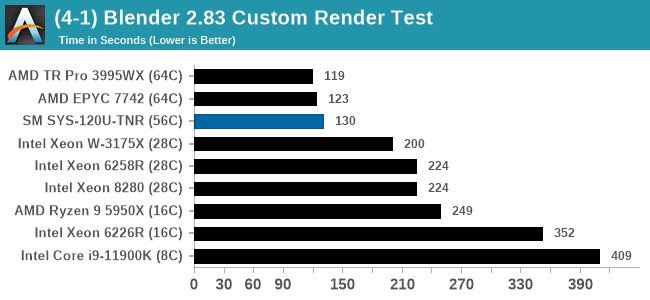
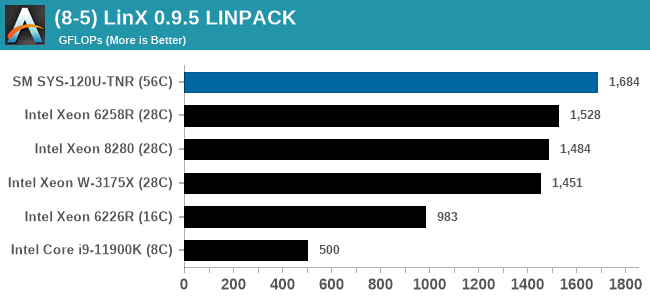
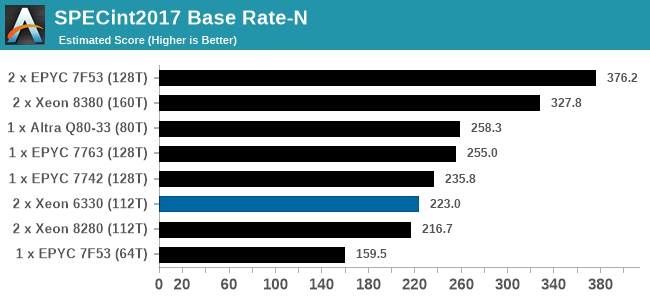
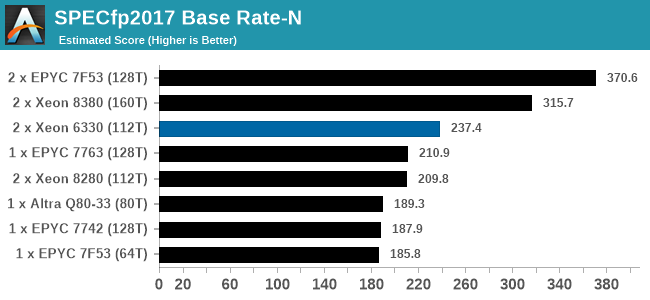
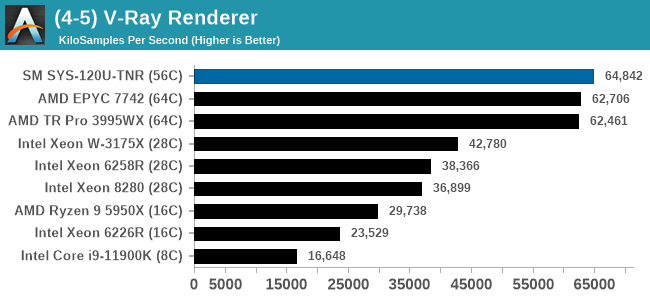
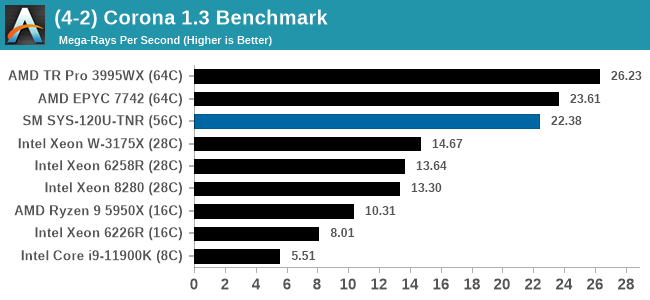
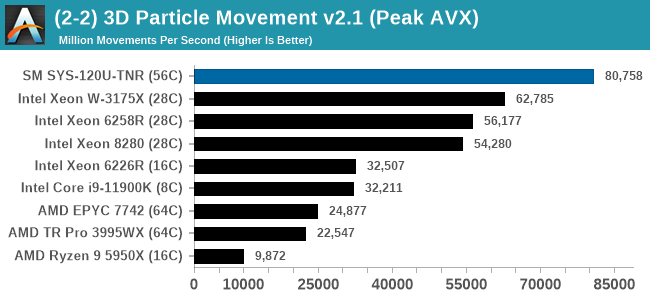
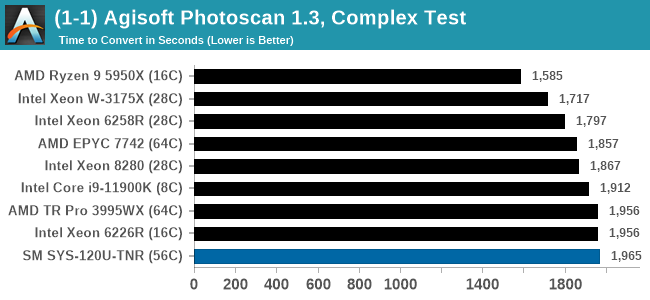
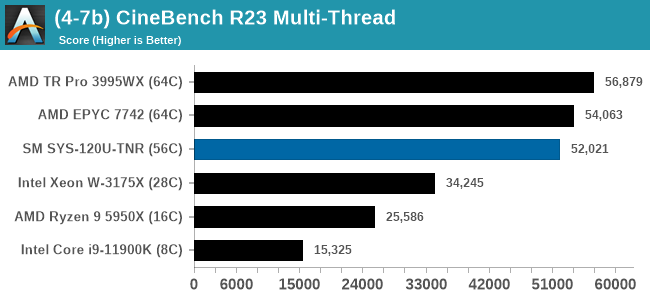
In almost all cases, the dual socket 28C SYS-120U-TNR sits behind the single socket 64C option from AMD. For the tests against dual 8280 or dual 6258R, we can see a generational uplift, however there is still a struggle against a AMD's previous generation top tier processor. That said, AMD's processor costs $6950, whereas two of these 6330s is around $3800. There is always a balance between price, total cost of ownership, and benefits versus the complexities of a dual socket system against a single socket system. The benchmarks where the SYS-120U-TNR did the best were our AVX tests, such as 3DPM and y-cruncher, where these processors could use AVX-512. As stated by Intel's Lisa Spelman in our recent interview, "70% of those deal wins, the reason listed by our salesforce for that win was AVX-512; optimization is real".


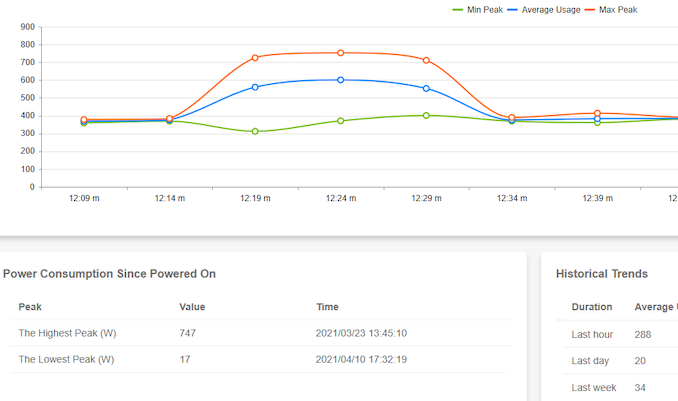
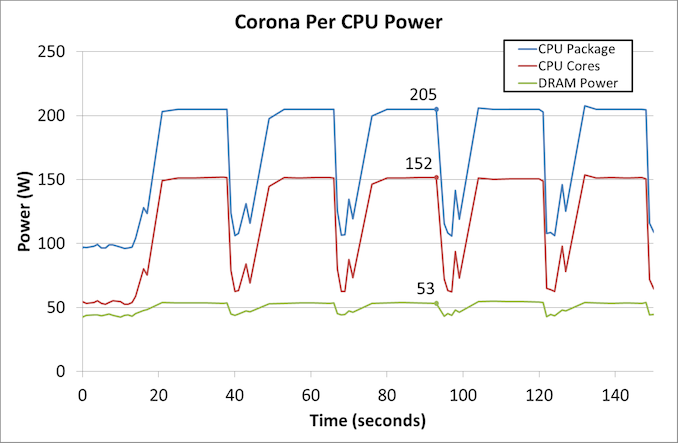
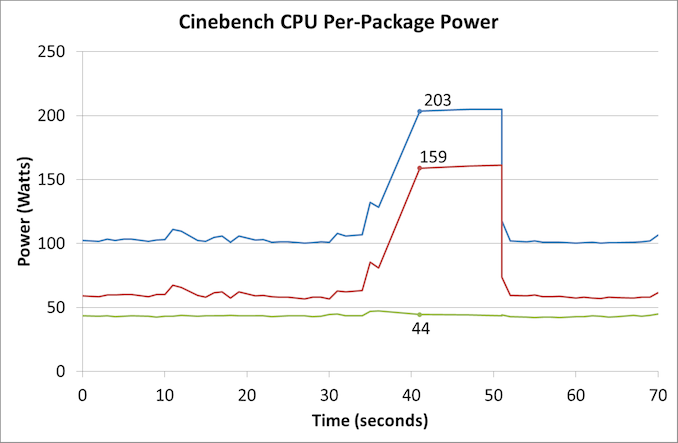








53 Comments
View All Comments
hetzbh - Thursday, July 22, 2021 - link
So ... 70% of the sales win are due to AVX 512? Better hope that Intel finds another strategy as AMD EPYC Genoa adds AVX 512 support as well..Kamen Rider Blade - Thursday, July 22, 2021 - link
I concur, don't forget that they're getting Stacked L3 3D V-Cache.The Vorlon - Saturday, July 24, 2021 - link
Zen with 3D cache vs Saphire Rapids with HBM should be interesting.Early returns from Adler Lake (same Golden Cove core as Saphire) suggests intel will have a +/- 25% IPC lead, but AMD will retain a large power consumption advantage - it is hard to project how much of this IPC intel will need to give back to keep reasonable thermals. HBM should outperform 3D cache by a good margin, but given what we (think) we know about yields AMD may still have a lead in core counts...
Fun times ahead!
Jorgp2 - Thursday, July 22, 2021 - link
Lol, no.mode_13h - Thursday, July 22, 2021 - link
I wonder how much of this is customers simply buying into the performance story of AVX-512 and purchasing the promise vs. actually having AVX-512 workloads where it proves worthwhile.zepi - Thursday, July 22, 2021 - link
There are multiple reasons to buy Intel.One often critical one is availability / lead time. Second one is that some software is not supported on AMD or you need to pay additional HW validation bills and subject yourself to intricate details of tuning your network stack / firmwares / network cards and whatnot when you run a bit more special software.
mode_13h - Thursday, July 22, 2021 - link
> There are multiple reasons to buy Intel.Sure, but I'm not asking about that. I'm asking about the specific claim quoted in the article and mentioned by @hetzbh.
edzieba - Thursday, July 22, 2021 - link
"I wonder how much of this is customers simply buying into the performance story of AVX-512 and purchasing the promise vs. actually having AVX-512 workloads where it proves worthwhile."Very little: in this realm you don't buy hardware based on specs and review benchmarks, you have samples in house running your ACTUAL workload to determine real performance before rolling it out at scale.
mode_13h - Thursday, July 22, 2021 - link
And you know this from experience, or are you just speculating? And if the former, were you on the sales side or a volume purchaser?domih - Thursday, July 22, 2021 - link
I know that by experience. I spent two months testing 3 different racks of 20 units (two major brands and a "no brand" OEM) to advise a large purchasing customer on which ones to select. The final advice is not reduced to a Yes or No but rather the pros and cons of each system. The best benchmark results are not the only factor, software compatibility, manuals, professional services, training programs, existing relations with vendor, other support and pricing (final deal) count a lot too. In the end, using a comprehensive check list, you may select not the fastest system or even a system that has bugs (but with workarounds) due to significant difference in pricing or other arrangements. Utterly different from the DYI market. Analog: if you're going to buy 100 x 18-wheel trucks, you're going to spend quite some time evaluating the possible candidates and it will take time. Utterly different than going to a car dealer and buy a car on the spot.